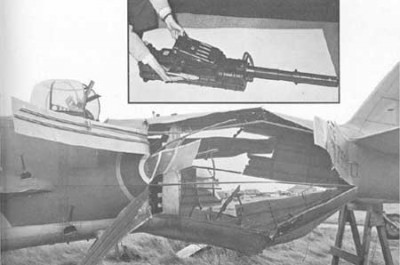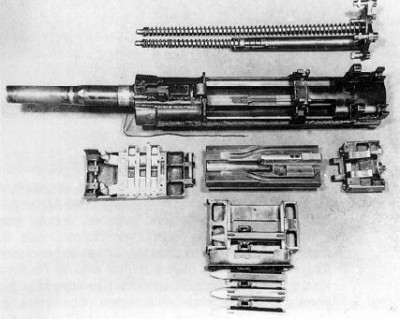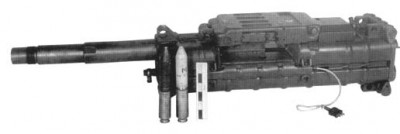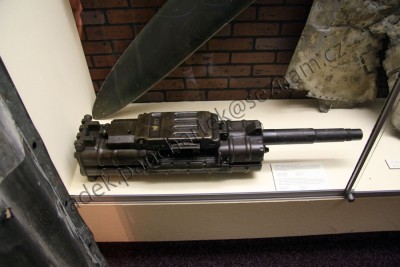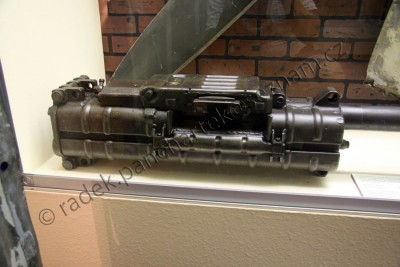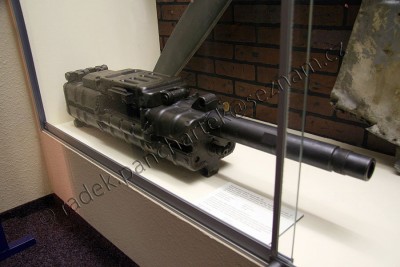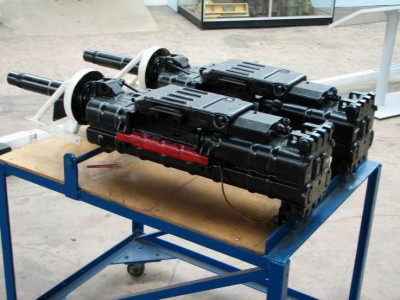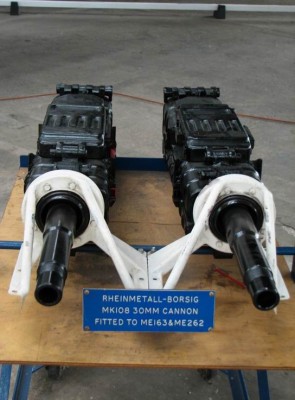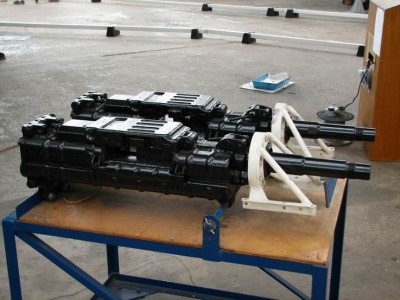| Název: Name: | MK 108 | MK 108 |
| Originální název: Original Name: | MK 108 | |
| Výrobce: Producer: | Rheinmetall-Borsig, Düsseldorf, Berlin and Unterlüß | |
| Období výroby: Production Period: | DD.MM.1943-DD.MM.1945 | |
| Vyrobeno kusů: Number of Produced: | ? | |
| Prototyp vyroben: Prototype Built: | DD.MM.1942 | |
| Použití: Use: | Bv 155 - prototype flown Bv 40 - 6 examples built Fw 190 - variants Ta 152 C and H Ta 154 He 219 Ho 229 - prototype flown He 162 - prototype Ju 388 J-1 night fighter version Bf 109 G-6/U4 and K-4 Bf 110 G-2 Me 163 Me 209 Me 262 Me 410 B-2/U2/R2 version | |
| Technické údaje: Technical Data: | ||
| Hmotnost: Weight: | 58 kg | 128 lb |
| Ráže: Calibre: | 30 mm / 1.18 inch | |
| Náboj: Cartridge: | 30×90RB | |
| Délka hlavně: Barrel Length: | 545 mm | 1ft 9,5in |
| Celková délka: Overall Length: | 1057 mm | 3ft 5,6in |
| Používaná munice: Ammo Used: | Průbojné tříštivé zápalné (370 g) zápalné (330 g) V praxi se nakonec používal pouze dva typy munice Minengeschoß tříštivé-zápalné a zápalné. | AP HEI Incendiary In practice however only two major ammunition types were used: "mine-shell" - high-explosive incendiary and incendiary. |
| Výkony: Performance: | ||
| Maximální dostřel: Maximum Range: | 1 km | 0.6 mi |
| Rychlost střelby: Rate of Fire: | 650 ran/min | 650 rpm |
| Úsťová rychlost: Muzzle Velocity: | 505 - 540 m/s | 1640.4 - 1771.7 ft/s |
| Poznámka: Note: | Největším nedostatkem této zbraně byla nízká úsťová rychlost a to recipročně znamená také malý účinný dostřel. Pravdou je, že kanón MK 108 byl navržen pro boj s bombardéry, které nejsou schopny provádět obranné manévry, protože letí v boxech, ale i proti těmto bombardérům musela být palba vedena ze vzdálenosti 200 - 300 m. Při střelbě na vzdálenost 1 000 m poklesl granát o 41 m. Balistická křivka byla dosti strmá. Používaná munice byla typu M-geschloss, granáty byly vyrobeny tažením z kvalitní oceli. Stěna granátu byla poměrně tenká, ale do vzniklé větší dutiny v granátu bylo vloženo více vysokoexplozivní výbušniny. Tento granát měl značný destruktivní účinek, ale tenkostěnný obal nevytvořil velké množství střepin. | Low muzzle velocity was the MK 108's main shortcoming, giving it a limited effective range. It was designed for use against bombers, which could not maneuver due to the need to stay in formation, but also against the enemy bombers was a effective range very short (650 - 950 ft). |
| Zdroje: Sources: | http://www.deutscheluftwaffe.de/.../rheinmetall108.htm#Technische Daten users.skynet.be users.skynet.be http://robdebie.home.xs4all.nl/me163/weapons15.htm http://www.quarryhs.co.uk/WW2guneffect.htm http://www.stormbirds.com/warbirds/tech_mk108.htm http://www.airwar.ru/weapon/guns/mk-108.html | |
DEU - MK 108 (30 mm kanón)
MK 108
It is a single-ended air cannon manufactured by Rheinmetall Borsig. He was introduced into the armament of the Luftwaffe at the end of the war. This efficient cannon with relatively low weight and high reliability was produced in large series.
MK 108 cannon with some external features resembles its predecessor MK 103. However, it is significantly shorter, which was achieved by significantly shortening the barrel. He had an unlocked conclusion with the so-called pre-ignition, which was the principle used in the cannon MG FF, which was armed aircraft from the beginning of the war.
The weapon was designed for a completely new charge. It had an almost cylindrical cartridge case and increased effect in the target. Used in two explosive designs, one type of grenade was purely incendiary and one explosive-incendiary. The total length of these cartridges was 205 mm, which was much less than the cartridges for MK 103 with a length of 298 mm.
The construction of this new weapon was built on two foundation stones. The first was a new charge, which was significantly shorter than used so far. The second was the fact that during the attack, the fighter opened fire relatively close to the target, so it was not necessary to insist on high muzzle velocity of the projectile. Emphasis was placed mainly on high cadence, because the shooting itself always lasted a short time and therefore it was necessary to fire as many rounds in a short time.
The low muzzle velocity allowed designers to use an unlocked pre-ignition closure. The principle of its operation was based on the fact that the charge (with an almost cylindrical cartridge case) was finally inserted into the charge chamber of the stationary barrel and during this forward movement was initiated. Thus, at the beginning of the movement of the projectile in the barrel, part of the energy impulse of the shot first had to be used to stop the breech and only the remaining part then pushed the breech back. The use of pre-ignition thus made it possible to significantly reduce the weight of the breech, due to its lower stress by firing pressures and shocks. The initialization of the match on the MK 108 was electrical. The remote control of the whole weapon was designed as electro-pneumatic.
The feed mechanism of the weapon was very interesting. This cannon lacked a bouncer. After firing, the cartridge case, after being pulled out of the cartridge chamber, was first pulled back into the article of the cartridge belt. Then the belt was moved and the empty cartridge was removed from the weapon. As soon as the article with the cartridge left the space of the so-called table feed mechanism, it was separated from the cartridge belt. It was designed as a crumble with an empty cartridge. The reason preventing its earlier disintegration into individual cells was the projectile itself.
The MK 108 cannon proved very useful in combat. He excelled in the given caliber with a relatively small weight and simple installation in aircraft. His 30 mm grenade had such an effect on the target that often even two hits were enough to destroy the target.
Example of ammunition used:
30 mm inflammable-jerking
Cartridge weight: 475 g
Bullet weight: 370 g
Dust weight: 29.5 g
Hub length: 205 mm
Muzzle velocity: 500 m/s
Sources:
- L. Popelínský, Aircraft Rifle and Missile Armament, Our Army 1997, ISBN 80-206-0531-2
- J. Schmid, Aircraft 1939-45 (Germany 1/2), Jiří Fraus 1993, ISBN 80-85784-02-5/80-85784-10-6
- author's archive
It is a single-ended air cannon manufactured by Rheinmetall Borsig. He was introduced into the armament of the Luftwaffe at the end of the war. This efficient cannon with relatively low weight and high reliability was produced in large series.
MK 108 cannon with some external features resembles its predecessor MK 103. However, it is significantly shorter, which was achieved by significantly shortening the barrel. He had an unlocked conclusion with the so-called pre-ignition, which was the principle used in the cannon MG FF, which was armed aircraft from the beginning of the war.
The weapon was designed for a completely new charge. It had an almost cylindrical cartridge case and increased effect in the target. Used in two explosive designs, one type of grenade was purely incendiary and one explosive-incendiary. The total length of these cartridges was 205 mm, which was much less than the cartridges for MK 103 with a length of 298 mm.
The construction of this new weapon was built on two foundation stones. The first was a new charge, which was significantly shorter than used so far. The second was the fact that during the attack, the fighter opened fire relatively close to the target, so it was not necessary to insist on high muzzle velocity of the projectile. Emphasis was placed mainly on high cadence, because the shooting itself always lasted a short time and therefore it was necessary to fire as many rounds in a short time.
The low muzzle velocity allowed designers to use an unlocked pre-ignition closure. The principle of its operation was based on the fact that the charge (with an almost cylindrical cartridge case) was finally inserted into the charge chamber of the stationary barrel and during this forward movement was initiated. Thus, at the beginning of the movement of the projectile in the barrel, part of the energy impulse of the shot first had to be used to stop the breech and only the remaining part then pushed the breech back. The use of pre-ignition thus made it possible to significantly reduce the weight of the breech, due to its lower stress by firing pressures and shocks. The initialization of the match on the MK 108 was electrical. The remote control of the whole weapon was designed as electro-pneumatic.
The feed mechanism of the weapon was very interesting. This cannon lacked a bouncer. After firing, the cartridge case, after being pulled out of the cartridge chamber, was first pulled back into the article of the cartridge belt. Then the belt was moved and the empty cartridge was removed from the weapon. As soon as the article with the cartridge left the space of the so-called table feed mechanism, it was separated from the cartridge belt. It was designed as a crumble with an empty cartridge. The reason preventing its earlier disintegration into individual cells was the projectile itself.
The MK 108 cannon proved very useful in combat. He excelled in the given caliber with a relatively small weight and simple installation in aircraft. His 30 mm grenade had such an effect on the target that often even two hits were enough to destroy the target.
Example of ammunition used:
30 mm inflammable-jerking
Cartridge weight: 475 g
Bullet weight: 370 g
Dust weight: 29.5 g
Hub length: 205 mm
Muzzle velocity: 500 m/s
Sources:
- L. Popelínský, Aircraft Rifle and Missile Armament, Our Army 1997, ISBN 80-206-0531-2
- J. Schmid, Aircraft 1939-45 (Germany 1/2), Jiří Fraus 1993, ISBN 80-85784-02-5/80-85784-10-6
- author's archive
Reklama
This post has not been translated to English yet. Please use the TRANSLATE button above to see machine translation of this post.
Reklama
Kanón Mk-108 A3, Wehrtechnische Studiensammlung Koblenz , Germany, 2009. (photo © Radek Havelka)
[img] https://galerie.valka.cz/data/843/medium/IMG_8035.jpg[/img ]
[img] https://galerie.valka.cz/data/843/medium/IMG_8035.jpg[/img ]
The Czechoslovak designation kan & # 243; na bolo vz. 108/30N. He formed an armament of several pieces of fighters Avia S-92. As of March 16, 1946, there were 170 pieces of them and 23,000 pieces of ammunition in Czechoslovakia. His tests took place in 1948 on a fighter Avia S-92.2.
Source:
Irra, Miroslav: Avia S/CS-92. Me-262 in the Czechoslovak Air Force
Source:
Irra, Miroslav: Avia S/CS-92. Me-262 in the Czechoslovak Air Force
Diskuse
I am sending a link to an English written page dedicated to this weapon. The site contains a technical description of the weapon and ammunition, as well as technical documentation, photographs and a list of types of aircraft where the weapon was mounted, as well as a list of types where the installation was planned.
http://www.luft46.com/armament/mk108.html
http://www.luft46.com/armament/mk108.html
Join us
We believe that there are people with different interests and experiences who could contribute their knowledge and ideas. If you love military history and have experience in historical research, writing articles, editing text, moderating, creating images, graphics or videos, or simply have a desire to contribute to our unique system, you can join us and help us create content that will be interesting and beneficial to other readers.
Find out more